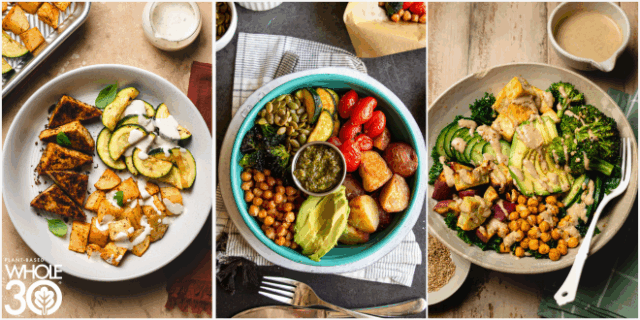Your taste buds recognize five different flavors: sweet, sour, salty, bitter, and savory—or umami. When most people think of umami, a meaty, savory flavor comes to mind. But did you know that plenty of non-animal-based foods have umami flavor?
It’s true. And these ingredients can add depth and richness to your plant-based cooking. From mushrooms to miso to seaweed, there are a variety of plant-based foods with umami flavors.
You’ll find a shopping list for umami ingredients, along with cooking tips and recipe ideas below. But to fully unlock umami in your diet, it helps to first have a deeper understanding of the flavor itself.
What is Umami?
Umami is an important fifth flavor that’s distinct from sweet, sour, salty, and bitter. It is often thought of as the “savoriness” or “meatiness” found within foods. It’s a full-bodied flavor that adds a layer of complexity to dishes and enhances the overall taste.
For example, an umami-rich dish of mushrooms sautéed with garlic can be more flavorful than cooking without that savory combination.
The knowledge of this flavor has been around for a long time. In fact, it was first discovered by a Japanese chemist more than one hundred years ago. Now we know the unique umami flavor comes from naturally occurring glutamate, which is an amino acid that is tasteless on its own.
What is Glutamate?
Glutamate is an amino acid—molecules combined together to make proteins. Glutamate can be found in fermented products like miso, soy sauce, and seaweed, as well as tomatoes and even mushrooms. The umami flavor is usually caused by glutamic acid or aspartic acid.
Glutamic acid is what the body turns into the glutamate that comes from food sources. Aspartic acid is a nonessential amino acid naturally produced by plants and animals. These two amino acids are part of many different proteins and plant-based foods. For example, ripe tomatoes, soy sauce, and walnuts all contain glutamic acid. While asparagus and avocado contain aspartic acid.
Glutamate not only comes naturally from occurring in foods but also from spices and seasonings—including monosodium glutamate (MSG).
This flavor enhancer has been used in Asian cuisines for centuries. It is composed of the same umami-rich glutamates found naturally in food, and can be added to dishes for an increase in savory flavors.
Contrary to popular belief, MSG is safe to consume and does not cause headaches or other health problems. That’s why, in 2022, MSG became Whole30 compatible. However, MSG should still be used in moderation and balanced with other flavors.
Your Go-To Umami Foods List
You may already be cooking with umami ingredients and not even know it. This is especially true of the plant-based foods on your plate. Many plant-derived foods are naturally rich in glutamate.
If you’d like to be more intentional about incorporating this flavor, here are some Plant-Based-Whole30-compatible umami foods to start adding more often:
- Mushrooms – All types are good sources (including shiitake, oyster, portobello, and more)
- Tomatoes
- Miso – This Japanese seasoning is made from fermented soybeans, and it has an intense umami flavor that can be used to season soups and other dishes.
- Kombu/ Seaweed – Dried kombu and other seaweeds are big umami bombs.
- Nutritional Yeast
- Garlic
- Green peas
- Potatoes
- Kimchi– fermented vegetables, often cabbage based
- Soybeans– All types (including tofu, edamame, and tempeh)
Not only do whole foods have umami, but spices do, as well. Stock up your pantry with this list of umami-rich spices—they’re in order from highest content to lowest:
- Paprika
- Garlic powder
- Ground mustard seed
- Fennel seed
- Onion powder
- Curry powder
- Chili powder
- Yellow mustard
- Black pepper
- Dried basil
These are just some of the umami ingredients you can incorporate into your cooking. The flavors can be especially beneficial for newer plant-based eaters looking for more savory, meat-like dishes.
Tips for Cooking with Umami Flavor
When cooking with umami flavors, don’t be afraid to try new things. From broths and sauces to stocks and seasoning blends, you can play around with all the umami ingredients above. Experimenting with these umami foods will help you find what you enjoy the most.
When adding savory undertones to your dish, remember that a little goes a long way. Start slow and season to taste as you go. A pinch of smoked paprika or miso can really add some extra oomph.
Balance is important to cooking the most mouth-wateringly delicious food possible. Just make sure not to overpower the other ingredients in your dish—otherwise the flavor combination may not mesh well. So be daring with the umami-rich dishes you cook, but be measured in adding super savory ingredients to all your food!
Umami Plant-Based Recipe Ideas
You’ve made it this far, so you know plant-based meals can have a delicious umami flavor without relying on meat or other animal products. Using the tips outlined in this article will help you be ready to put the lessons about umami flavor into practice.
Adding umami-rich ingredients to your cooking may be easier than you think. Start by trying some of these recipes ideas featuring plant-based foods with big umami flavor:
- Portobello Mushroom Burgers — These burgers are packed with robust, meaty flavors. Try your grilled portobellos with a miso glaze and tangy pickles, served with leafy greens.
- Stuffed Sweet Potatoes — These loaded potatoes combine smoky flavors with the sweetness of roasted sweet potatoes for a unique savory flavor.
- Grilled Eggplant with Pesto — This dish is simple yet full of flavor. The combination of eggplant, dairy-free pesto, and nutritional yeast is packed with umami. You could also try these Eggplant Boats.
- Lentil Walnut Tacos — Walnuts are one of the most savory nuts you can find. And these tacos highlight their umami flavor.
Umami is a delicious taste that can enhance your plant-based meals. By adding these ingredients to your recipes, you can create hearty, flavorful meals that support you during your plant-based Whole30 and beyond. With a little practice and experimentation, you’ll be a master of cooking with umami flavors in no time!















